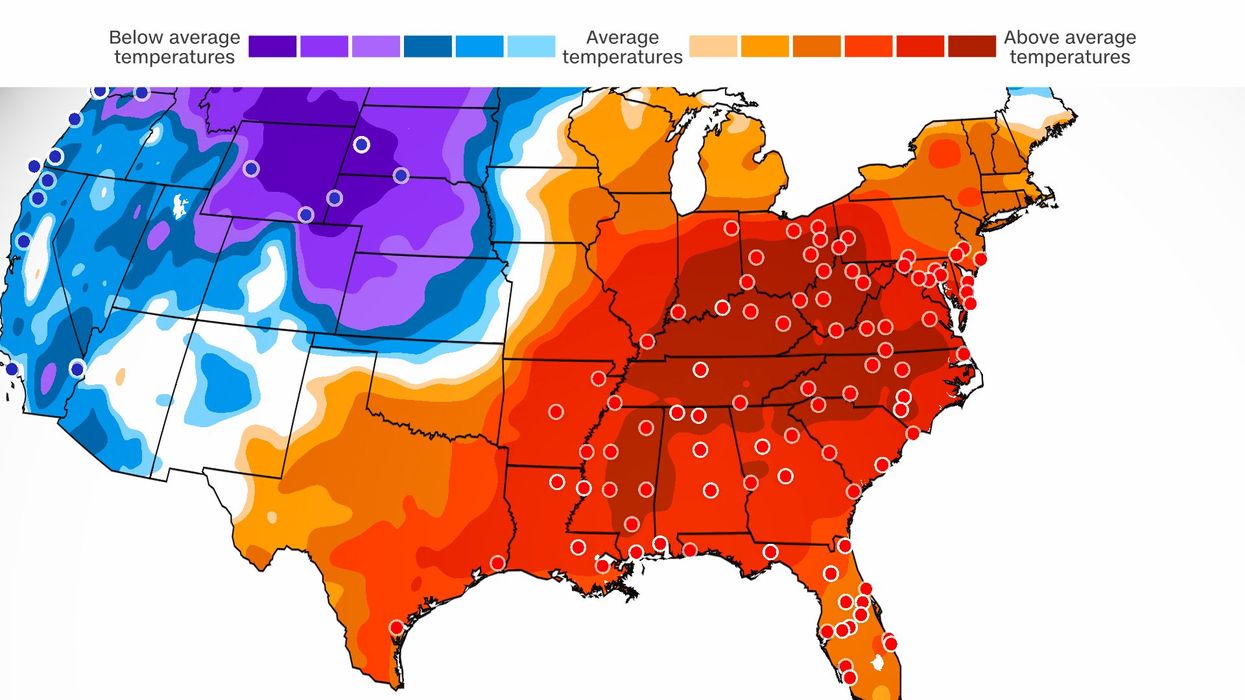(CNN) — As parts of the West and Northern US face a winter storm with blizzard conditions and significant snowfall, much of the rest of the country is experiencing a summer-like heat that has never been felt before during the month of February.
More than 130 cities from the Gulf of Mexico to the Great Lakes could set new records for daily and monthly high temperatures this week. Highs will climb up to 80 degrees as far north as Ohio and West Virginia — certainly unusual, but becoming less so in the warming climate.
Here's a stark example: Before this decade, Charleston, West Virginia, had only hit 80 degrees before March three times in more than 100 years of record-keeping. But this week's incredible warmth will mean that four of the last six years will have logged temperatures of 80 degrees, which is its normal high on June 1, in February.
Record warmth in February — a time that's supposed to still feel like winter — might not sound like such a bad thing, but its negative consequences spread across the plant world, sports, tourism and agriculture. And it is another clear sign that our planet is warming rapidly, experts say.
"Whenever we get these events, we should always be thinking there's the possibility or likelihood that human-induced climate change is increasing the likelihood of strange weather," Richard Seager, climate researcher at the Lamont-Doherty Earth Observatory of Columbia University, told CNN. "The more it goes on, the more they can bring such tremendous damage."
Deadly thin ice
On the Great Lakes, ice coverage reached a record low for this time of the year — the same time that the annual maximum extent of ice usually occurs. As of last week, only 7 percent of the five freshwater lakes were covered in ice, a sharp difference from the 35 to 40 percent ice cover typically expected in mid-to-late February, according to the National Oceanic and Atmospheric Administration.
Great Lakes ice is on a downward trend, NOAA scientists report. A recent study found a 70% decline in the lakes' ice cover between 1973 and 2017.
The decline in Great Lakes ice each winter may not seem like it has any harmful impact, but that ice acts as a buffer for large, wind-driven waves in the winter, scientists have reported. Without the ice, the coastlines are more susceptible to erosion and flooding.
Ayumi Fujisaki-Manome, a research scientist at NOAA's Cooperative Institute for Great Lakes Research at the University of Michigan, said low ice coverage could also set the stage for another severe lake-effect snow storm like the one Buffalo, New York, experienced in December.
"The moisture and heat from the lake surface water are absorbed into the atmosphere by storm systems, and then fall back to the ground as snow in the winter," Fujisaki-Manome said in a statement.
The thin ice has already had deadly consequences in New England.
At Vermont's Lake Champlain, the annual ice fishing tournament was cancelled last weekend when three fishermen died after falling through the ice. One man's body was found hours after he was expected to return home from the lake, while the other two died after their utility vehicle broke through the ice.
Montpelier, Vermont, had its warmest January on record this year since 1948, with Burlington recording its fifth warmest January since 1884, according to the Burlington National Weather Service.
Robert Wilson, a professor of geography and environment at Syracuse University, said the Northeast as a whole is now a "fast-warming region," with winter seasons warming faster than summers due to the climate crisis.
And he underscored how this trend is threatening some of New England's most cherished winter activities.
"In coming decades, winter — as most people understand it — will get shorter and warmer, with less snow and more rain," Wilson said. "This poses a serious threat to winter recreation: snowmobiling, cross-country skiing, and downhill skiing."
The risk to food crops
Plants are blooming way earlier than usual across much of the country, a clear sign that spring is either right around the corner — or it has already arrived, in some places.
"Spring is coming early in much of the Southern and Eastern US," Brad Rippey, meteorologist with the US Department of Agriculture, told CNN. "Here in the mid-Atlantic, that means everything from budding trees to crocuses in bloom to spring peepers making lots of noise — and in February, no less."
Many plants species — including daffodils, witch-hazel, forsythia and even cherry blossoms — are beginning to leaf out in the East. Theresa Crimmins, director of the USA National Phenology Network, said it's the plants responding to very early warm temperatures.
"Plants, especially those of temperate systems, respond to a number of cues in order to wake up in the spring, including exposure to chill in the winter, exposure to warmth in the spring, and day length," she told CNN.
If another cold snap occurs after an early warm spell, Crimmins said it could be disruptive and damaging for the plants' cycle. As flower buds develop, many species lose their ability to tolerate cold temperatures, which means a freeze could kill blooms and leave fruit crops and other commodities vulnerable to spring freezes.
Rippey said warm winters followed by a spring freeze has become more common in recent years. In 2017, for instance, a severe spring freeze in March damaged several fruit crops — peaches, blueberries, apples and strawberries — in states including Georgia and South Carolina, which carried an economic toll of roughly $1.2 billion.
"As nice as it feels to have temperatures in the 70s and 80s this time of year, the fact that it's not 'normal' can have a profound impact on the ecosystem," Rippey said. "Even a typical spring freeze can damage commercial and back-yard fruit crops that have been pushed into blooming by late-winter warmth."
This isn't just a US problem
India issued its first heatwave alert, with temperatures in some states reaching 39 degrees Celsius (102 Fahrenheit) — up to 9 degrees Celsius (16.2 Fahrenheit) above normal, according to data released by the India Meteorological Department on Monday.
"The heatwave warnings as early as February is a scary situation," Krishna AchutaRao, a professor at the Centre for Atmospheric Sciences at the Indian Institute of Technology Delhi, told CNN.
It has raised fears of a repeat of last year's deadly heatwave, which scorched swaths of India and Pakistan.
Blistering heat has devastating consequences for people's health, for water supplies and for crops; last year, crop yields were reduced by as much as a third in some parts of the country. As temperatures soared last spring, India banned exports of wheat, dashing hopes that the world's second-largest wheat producer would fill the supply gap caused by the war in Ukraine.
This February, with high temperatures hitting wheat-producing states, including Rajasthan and Gujarat, India has set up a committee to monitor the impact of rising temperatures on the crop, according to Reuters.
Europe, too, has seen unusually high temperatures, kicking off 2023 with an extreme winter heatwave that broke January temperature records in several countries. Low levels of snow and rainfall have fueled concerns about the region's rivers and lakes.
The River Po, which winds through northern Italy's agricultural heartland, fed by snow from the Alps and rainfall in the spring, is at very low levels, while water in Lake Garda in northern Italy has reached record lows. There are fears Italy, which declared a state of emergency last year after its worst drought in 70 years, may face another drought.
The unusually warm weather has also left ski resorts across the Alps with little or no snow. In February, top skiers wrote an open letter to the International Ski and Snowboard Federation demanding action on the climate crisis.
"The seasons have shifted," they wrote. "Our sport is threatened existentially."
While ski resorts have adapted to warming by relying on artificial snow — a process that uses a lot of water and energy — Wilson noted that resorts would still need cold nighttime temperatures to make it.
"The long-term survival of skiing and other winter recreation will depend on nations lowering their carbon emissions to avoid the more dire consequences and severe warming in the future," he said.
The-CNN-Wire
™ & © 2023 Cable News Network, Inc., a Warner Bros. Discovery Company. All rights reserved.
- Extreme Heat Could Endanger 40 Percent of Land Animals ›
- Planting Trees in Cities Could Prevent One Third of Heat Deaths, Study Finds ›


















































